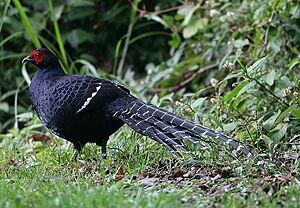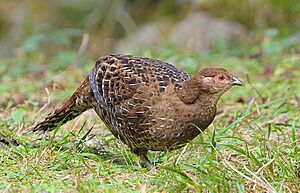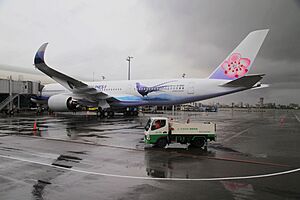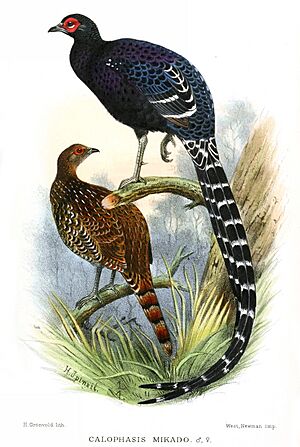Mikado pheasant facts for kids
Quick facts for kids Mikado pheasant |
|
|---|---|
 |
|
| Male | |
 |
|
| Female | |
| Conservation status | |
| Scientific classification | |
| Genus: |
Syrmaticus
|
| Species: |
mikado
|
| Synonyms | |
|
|
The Mikado pheasant (Syrmaticus mikado) is a beautiful bird that belongs to the pheasant family. These birds are sometimes called an unofficial "national bird" of Taiwan. You can even see a pair of Mikado pheasants and Yushan National Park on the 1000 dollar bill in Taiwan!
Contents
Where Mikado Pheasants Live
The Mikado pheasant lives only in the mountains of Taiwan. They like to live in thick bushes, bamboo forests, and grassy areas with conifer trees. You can find them in central and southern Taiwan, high up in the mountains, from about 2000 to 3200 meters above sea level.
What Mikado Pheasants Look Like
Male Mikado pheasants are quite large, growing up to 70 centimeters long, including their long tails. Females are smaller, reaching about 47 centimeters.
The male birds are very striking. Their feathers are dark, but they shimmer with blue or violet colors in the light. They also have cool white stripes on their wings and tail.
Female pheasants are mostly brown with speckles of brown and white. The long, striped tail feathers of the male were once used by the native people of Taiwan as decorations for their head-dresses. The very first Mikado pheasant specimen studied by scientists was actually just two of these tail feathers! They were found in 1906. The bird was named in honor of the Emperor of Japan, as Taiwan was under Japanese rule at that time.
How Mikado Pheasants Behave
These pheasants often come out into open areas when it's lightly raining or after a heavy rain. The mist helps to hide them. They usually prefer to be alone or in pairs. They are often quiet but always alert to their surroundings.
Mikado pheasants can get used to people, especially in places where people feed them. If they are disturbed, they will slowly and carefully move into nearby plants to hide, instead of flying away in a panic. If they really need to, they can fly short distances, gliding down the side of a mountain.
Males are very protective of their space, defending an area about 200–400 meters around them. Both male and female pheasants make soft clucking sounds when they are eating. Males also make "ke, ke, ke" calls when they are fighting over a mate or their territory. Both sexes might quickly flap their wings to show off. During the time they are breeding, the male will run sideways with his body puffed up and his tail fanned out to impress a female.
Mikado pheasants are most active around dawn and dusk. This means the best time to spot them is usually early in the morning (around 5-6 a.m.) or late in the evening (around 6-7 p.m.). These times might change a bit depending on when the sun rises and sets during different seasons.
What Mikado Pheasants Eat
These pheasants walk around and look for food at the same time, much like chickens do. They search on the forest floor and along mountain paths. Their diet includes different kinds of fruit, leaves, plants, seeds, and small bugs. They especially like to forage on rainy and foggy days.
Mikado Pheasant Sounds
Mikado pheasants make five main sounds:
- A deep "gu, gu, gu" sound: This is the most common sound. They make it often when they are relaxed, walking, or pecking the ground.
- A higher-pitched "ko, ko, ko": They usually make this sound during the breeding season or when they feel a threat nearby.
- A "ji, ji" sound: This is heard when they sense immediate danger from intruders.
- A "cu, cu" sound: This is their highest-pitched sound. They make it when they are startled and fly away. It's similar to the "ji" sound.
- A "hu, hu" sound: This sound is made when they are attacking something with their beak and claws. It's different from the other sounds because it seems to come from air being pushed out of their be beaks, not from their vocal cords.
Life Cycle of Mikado Pheasants
The breeding season for Mikado pheasants runs from March to June. They build their nests in tree holes or under rocks. They use things like dead branches, fallen leaves, dry grass, and feathers to make their nests cozy.
Female pheasants usually lay three to eight creamy-colored eggs at one time. The female is the only one who sits on the eggs to keep them warm. This takes about 26–28 days for the eggs to hatch. After the chicks are born, the mother takes care of them. The young pheasants are usually able to live on their own by the time they are six months old.
Protecting Mikado Pheasants
Some Mikado pheasants are raised in zoos or special breeding centers. In the wild, there are about 10,000 of these birds, especially in Yushan National Park. In the past, too much hunting was a big problem for them. However, hunting is not a serious threat anymore.
Because of conservation efforts, the number of Mikado pheasants has grown. For example, in Yushan National Park, their numbers went from 5,000 in 1986 to over 10,000 by 2020! They are also doing well in other national parks like Shei-Pa National Park and Taroko National Park.
The Mikado pheasant is listed as "near threatened" on the IUCN Red List of Threatened Species. This means they are not in immediate danger, but their population needs to be watched carefully. They are also listed on Appendix I of CITES, which means international trade of these birds is very restricted to protect them.
See also
- List of protected species in Taiwan
- List of endemic species of Taiwan
- List of endemic birds of Taiwan





